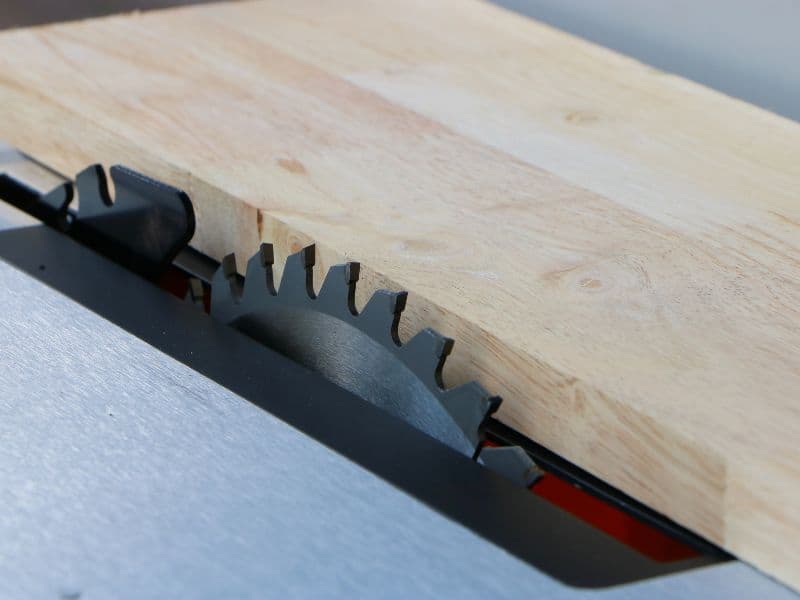
Knowing what blades are out there for your table saw and when to use them was something I didn’t completely grasp until lately. I wanted to pass the information along to others to help improve their table saw knowledge and maybe even help get better cuts on the table saw by being able to choose the correct blade for their situation. So what are the 3 most common table saw blades that you will use on your table saw?
The most common table saw blades for fine woodworking are rip blades, cross-cut blades, and combination blades. A rip blade is used for ripping lumber, a cross-cut blade is used for cross-cutting lumber, and a combination blade has characteristics that allow the blade to be used on both rip cuts and cross-cuts.
There are more blade types than just three, but the ones mentioned are the most common for fine woodworking use. In the next section, we will examine the three common types in more detail.
3 Table Saw Blade Types Explained
Rip Blade

A rip blade is going to be either a 10″ blade with 24 teeth, or a 12″ blade with 40 teeth. The lower tooth count allows you to rip wood quicker helping with eliminating burn marks and just makes the work quicker in general, which I’m not going to complain about.
Having a lower tooth count also helps with material removal because of the extra spacing between the teeth, also known as the gullet. When you are cutting lumber with the grain, the material removed tends to be in longer strips than if you were cutting across the grain.
The extra space helps get the wood chips out of the way for the next tooth. This makes the cut easier to perform and reduces problems that can arise from getting too much material clogged in between the teeth.
Cross-Cut Blade
The cross-cut blade is a blade with 60 teeth or more. This causes the distance between each tooth to be much closer than with a rip blade. The cut will be cleaner and useful when cutting against the grain.
When you cut against the grain, if you try to remove too much material at once, you can cause tear-out, which should be minimized when possible. Therefore, when you have a higher tooth count and the teeth are closer together, you remove smaller amounts of material with each pass of a tooth.
It takes a bit longer with more teeth, but it will produce much better results than using a blade with a low tooth count.
Combination Blade
A combination blade is a blade that can be used for ripping lumber or performing cross-cuts and is the preferred choice of many woodworkers. A combination blade will typically have somewhere between 40 and 60 teeth and is used to fill the need for both ripping and crosscutting.

The design of the blade was made so that it can perform well with ripping and cross-cutting lumber and remove the need to switch out the blade for the different types of cuts. It can yield decent results without changing the blade every other cut.
For the general woodworker, this would probably be the preferred route. You can spend more money on one blade of high quality instead of having to shell out money for two different high-quality blades. Depending on what type of work you plan on performing with your table saw, will determine if this blade will work for you.
Which Type of Table Saw Blade Gives the Smoothest Cut?
In general, the more teeth you have on a table saw blade, the smoother the cut will be. However, solely using a blade with more teeth for all your cuts will probably yield less than adequate results.
For instance, if you try to use an 80-tooth blade for a rip cut, not only will it take forever but you may also wind up burning the wood, and leaving dark marks along the face of the board that you cut. If you are having issues with burn marks when you cut wood, you can check out my other article here, which looks at some of the main issues that cause burning on your lumber.
To achieve the smoothest cut, you want to increase your blade tooth count while making sure you have a low enough tooth count to avoid other issues that might arise. So how many teeth is that? Well, there is a helpful article I wrote that you can read here, that dives into how many teeth you should be using on your table saw blade.
Which Type of Table Saw Blade is Best for Cutting Against the Grain?
When cutting against the grain, there is a problem that can happen if you use the wrong blade. The wood inherently wants to break with the grain, and if you are not careful, you can cause this to happen when cutting against the grain.
When wood breaks off beside where you are cutting, it is called tear out and can ruin a board, or at least make it unusable for what you were cutting it for. To fix it, you would need to cut the section that experienced the tear out, which makes it shorter than you intended. We want to avoid this right?
Well, the good news is that using the correct blade can help minimize or avoid this altogether. Since tear-out is especially susceptible to cross-cuts, when you are cutting in this direction you will want to use a high tooth count blade. A blade with more than 60 teeth is ideal.
The higher tooth count will take off less material with each tooth when compared to a low tooth count and reduces the size of the chips that it will produce. This is the best way to avoid or minimize tear-out. It will also produce a smoother cut. Since cross-cuts are not typically very long, the chance to burn the wood is minimal.
Final Thoughts
There are 3 main blades you will use on your table saw for fine woodworking; a rip blade, a cross-cut blade, and a combination blade. The rip blade and cross-cut blade have very specific purposes, while the combination blade is an altogether combination of the benefits of both. If you only could have one blade for woodworking, I would make it a combination blade.


